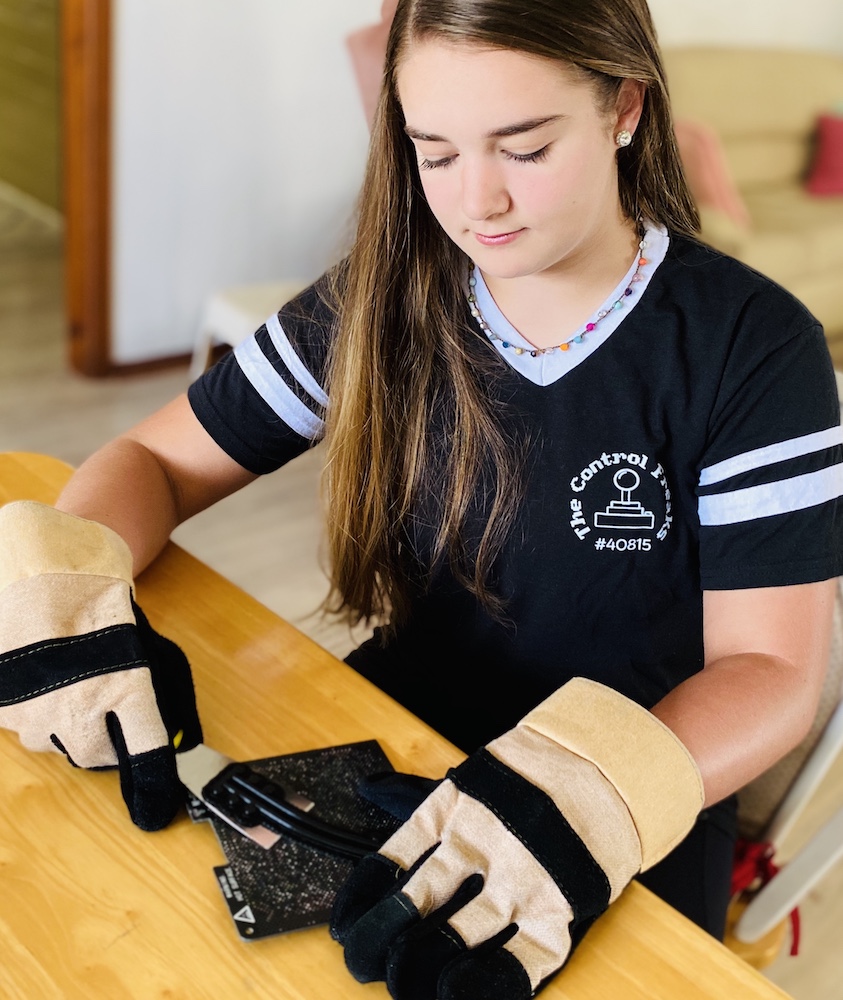Using 3-D printers to make ear savers, door grabbers for health care workers
While COVID-19 has closed schools throughout the United States, some students are using their education to help others. Middle school students at St. Bridget Catholic School, Richmond, under the guidance of their robotics teacher, have been using 3-D printers to manufacture equipment for health care workers.

Eric De Boer, one of two robotics coaches at St. Bridget, saw posts on social media about 3-D printing helping in the battle against the coronavirus by providing Personal Protective Equipment (PPE).
“After the diocese announced we would not be physically returning to school for the rest of the year, I thought we could put our 3-D printers to work during this pandemic,” he said, “Our school values service, and this seemed like a way for our students to serve our community.”
‘To do nothing would be wrong’
He sent emails to his students and their parents looking for volunteers. Quickly, 14-year-old eighth-grader Bridget Plank and 13-year-old seventh-graders Hayden Veech and Anthony Pennock replied. Turning their homes into makeshift factories, they have produced hundreds of items for health care workers.
The students were inspired by their faith, especially the Golden Rule.
“Jesus said, ‘Do unto others as you would have them do unto you,’” said Plank, “So if I were a health care worker during this time, I would want people to help me and my co-workers in any way they could.”
Veech added, “My faith taught me to treat others as you want to be treated. It would be wrong to do nothing.”
Fulfilling a need
With their team assembled — virtually, via Google Hangout — they got to work. De Boer knew the school’s printers were too small to print large PPE gear like face shields and masks, but he was also sure that workers on the frontline could still benefit from their help.
He connected with #MakeItThru Alliance, a group of engineers that has been coordinating efforts to produce and distribute 3-D-printed materials to local health care personnel and essential workers such as bus drivers and customer support staff.
The leader of the #MakeItThru Alliance, Jean-Etienne LaVallee, welcomed the students with socially-distant open arms. He told De Boer that there was a need for small items such as “door grabbers” and “ear savers” which could be printed on smaller 3-D printers.
Door grabbers are small plastic devices that hook over door handles, allowing people to open doors without actually having to touch the handles themselves. This helps reduce the spreading of germs.
Ear savers are designed to reduce irritation brought on by wearing facemasks. Each elastic ear band on a regular surgical mask hooks on to one end of the ear saver, alleviating the pressure on the ears themselves.
The ear saver strap, which can be adjusted for size, sits at the back of a person’s head. This provides relief to hospital workers who wear masks for several hours at a time.

Providing hope, encouragement
While the robotics students have experience planning and producing objects, this is the first time they have had the responsibility of manufacturing products on their own.
Each student has a printer in their home. Adhering to quarantine guidelines, De Boer used video chat to give the students instructions for how to complete their projects. Once the student finishes a print job, they sanitize the product and put it in a plastic bag. They leave the bag in a “drop zone” at the school and members of #MakeItThru pick it up.
According to Veech, health care workers appreciate the students’ work.
“They loved that we were helping out with simple tools that made working much easier,” he said.
Once De Boer posted about the group on social media, several health care professionals expressed interest.
“In addition to the practical support this provided, there is also the emotional support felt when strangers reach out to help,” De Boer explained, “Knowing others around you care for you and are with you can provide a great sense of hope and encouragement.”
Working together
3-D printing is relatively inexpensive. Each spool of filament (the 3-D printer version of ink) costs around $20, and each spool can make dozens of ear savers or door grabbers.
St. Bridget teachers are chipping in to help cover the costs. It takes one hour to print a set of two door grabbers and a half-hour to make an ear saver.
“It feels just as good to give to others as to receive things yourself,” Plank stated.
The students have shown that people can work together for the greater good even if they aren’t physically together. They believe helping others is what will get people through this pandemic.
“I am very hopeful about the future because I know that when this is all over, I will feel so relieved that life is finally getting back to normal,” Pennock said. “I think that COVID-19 has brought the countries of the world closer together because we are all working together to end this virus.”
De Boer, whose wife is a physician, recalled how one day she was conducting COVID-19 testing at a drive-thru clinic. The face shield she was wearing was donated by none other than the #MakeItThru Alliance.
“Seeing that connection made my eyes well up with tears,” De Boer said, “It felt like God saying, ‘I am here. I am working. I am your protector and provider. I am your shield.’”
Editor’s note: For more information, please call St. Bridget Catholic School at 804-420-4940

